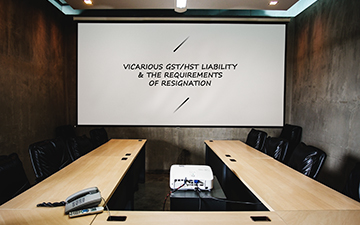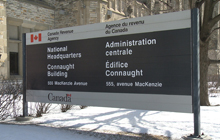Director dodges vicarious tax liability by proving resignation

Singh v The Queen (2019 TCC 120)
 |
David J. Rotfleisch, CPA, JD, is the founding tax lawyer of Rotfleisch & Samulovitch P.C. |
TORONTO – Under certain conditions, a director may become personally liable for a corporation's unremitted net tax. Section 323 of the Excise Tax Act gives the Canada Revenue Agency a means of pursuing a corporation's director for the corporation's unremitted GST/HST. (The Income Tax Act contains an analogous rule relating to a corporation's unremitted source deductions.)
To pursue a director on the basis of section 323, the CRA must assess the director within two years of the date that the director "last ceased to be a director" of the debtor corporation. In other words, the CRA cannot successfully assess a director under section 323 if that director resigned more than two years prior.
This raises the question: How does a director prove the date of resignation if the CRA insists otherwise? This very question was at issue in Singh v The Queen (2019 TCC 120).
After examining section 323 of the Excise Tax Act, this article reviews the Tax Court's decision in Singh and offers some tax tips based on the decision.
Director's Liability under Section 323 of the Excise Tax Act
Section 323 expands the CRA's power to collect a corporation's unremitted GST/HST when efforts to collect against the corporation prove futile. In other words, it is a tax collection tool.
Specifically, if the corporation failed to remit GST/HST, subsection 323(1) confers vicarious tax liability on "the directors of the corporation at the time the corporation was required to remit." Each director becomes "jointly and severally liable" to pay the corporation's unremitted GST/HST.
The vicarious GST/HST liability under section 323 may apply to either a de jure director or a de facto director. A de jure director is one who is appointed in accordance with the governing corporate statute—that is, a legally appointed director. A de facto director, on the other hand, is one who in fact fulfils the duties of a director despite no legal obligation to do so. This typically involves an individual who either (i) continued acting as a director even after properly resigning from that post or (ii) was never a legally appointed director yet took on the responsibilities of a director. In other words, the vicarious tax liability under section 323 doesn't discriminate between a person who acts like a director and a person who is a director. Each faces the same exposure to a director's liability assessment.
Still, section 323 contains three checks. These checks serve to limit a director's personal exposure to a corporation's GST/HST debts. And they ensure that the CRA cannot pursue the directors until the corporation's assets prove insufficient to satisfy the GST/HST debt.
First, subsection 323(2) says that a director isn't liable for a corporation's unremitted GST/HST unless one of the following has occurred:
- The CRA registers a certificate for the corporation's GST/HST arrears with the Federal Court, obtains a writ of execution, and sends the sheriff out to enforce that writ by seizing the corporation's assets. But the corporation's assets prove insufficient to cover the registered GST/HST debt.
- The corporation has commenced liquidation or dissolution proceedings (or has been involuntary dissolved), and the CRA files a proof of claim for the corporation's GST/HST debt within the statutory time limit.
- The corporation has assigned itself into bankruptcy (or a creditor has obtained a bankruptcy order against the corporation), and the CRA files a proof of claim for the corporation's GST/HST debt within the statutory time limit.
Second, subsection 323(5) prescribes a two-year limitation period on a director's exposure to a corporation's GST/HST debt. The Canada Revenue Agency cannot assess a director for a corporation's GST/HST arrears "more than two years after the person last ceased to be a director of the corporation." The corporate statute governing the corporation identifies the conditions upon which a person ceases to be a director. Section 121 of Ontario's Business Corporations Act, for example, says that a director of an Ontario corporation ceases to hold office upon death, resignation, removal by the shareholders, or disqualification (e.g., mental incapacity or bankruptcy). In addition, subsection 121(2) says that a director's resignation takes effect on the later of: (i) the time that the corporation receives a written resignation and (ii) the time specified in the written resignation. (This rule permits a director to deliver written resignation in advance of the proposed retirement.) If the person continues acting as a de facto director, however, the clock on the two-year period does not start running.
Third, subsection 323(3) protects a director who exercised due diligence. A director isn't liable for the corporation's GST/HST debts if, to prevent the corporation's failure to remit, the director "exercised the degree of care, diligence and skill" that "a reasonably prudent person would have exercised in comparable circumstances."
Singh v The Queen, 2019 TCC 120
In 2007, Mr. Singh and his wife were directors of Ranadia Inc., an Ontario corporation. Ranadia failed to file GST/HST returns. As a result, in 2007 and 2008, the Canada Revenue Agency arbitrarily assessed Ranadia for GST/HST totaling about $15,000.
By 2015, Ranadia's $15,000 GST/HST debt had remained unsettled. In the summer of 2015, the CRA registered a certificate in Federal Court. In February 2016, the CRA filed a writ of seizure and sale against Ranadia for its still outstanding GST/HST debt. The sheriff attempted to collect on the writ, but the amount went uncollected.
On August 30, 2016, the Canada Revenue Agency assessed Mr. Singh personally for Ranadia's GST/HST debt under section 323 of the Excise Tax Act.
In response, Mr. Singh ultimately appealed to the Tax Court of Canada, where he alleged that he had resigned as Ranadia's director on June 3, 2011 — more than two years before the 2016 assessment for director's liability.
The sole issue before the court was whether Mr. Singh's evidence sufficed to show, on a balance of probabilities, that he had resigned on June 3, 2011. If so, then the director's liability assessment was invalid, and Mr. Singh incurred no personal liability. If not, then Mr. Singh would be vicariously liable for Ranadia's GST/HST debt (plus the interest that had accumulated since).
Mr. Singh tendered the following evidence of his resignation:
- A resignation letter indicating that Mr. Singh resigned as a director effective June 3, 2011. The document purported to be signed on the same date. It also included a notation indicating it had been hand-delivered and mailed to the corporation's registered office. (At the hearing, Mr. Singh testified that he also handed a copy of the resignation letter to his wife, who was the remaining director at the time.)
- Ranadia's directors' register showing that Mr. Singh had resigned on June 3, 2011.
- A shareholders' resolution approving Mr. Singh's resignation, a shareholders' resolution indicating that Mr. Singh's wife would be the sole director, and consent from his wife to act as sole director.
Mr. Singh had previously submitted a copy of each document to the CRA's Appeals Division about two years before the Tax Court hearing, in 2017, during the objection stage of the tax dispute.
The Canada Revenue Agency, in response, purported that the following evidence showed Mr. Singh had in fact not resigned in June 2011:
- In 2015, Mr. Singh failed to respond to two CRA letters alleging his vicarious liability for GST/HST as the director of Ranadia.
- In 2017, when Mr. Singh sent the resignation documents to the CRA, he delivered them in two tranches, about five or six days apart.
- While the Ranadia directors' register reflects Mr. Singh's resignation, it omitted any mention of the remaining director.
- Neither Mr. Singh nor Ranadia filed a notice of change to update the public registry about Mr. Singh's registration, as required by Ontario's Corporations Information Act.
The Tax Court rejected these concerns.
First, neither of the two CRA letters raised the issue of Mr. Singh's status as a director. Instead, they simply assumed that he was a director and asked that he provide evidence of his due diligence. Mr. Singh's non-response was therefore not germane to the question whether he was a director.
Second, the court dismissed the notion that the five or six day gap between the two tranches of resignation documents cast doubt on their legitimacy. The court observed that these documents were sent five days apart after discussions between a CRA agent and Mr. Singh. The court found that the two tranches of documents showed "contemporaneous legitimacy" because they were consistent, they were sent within a short period of time, and Mr. Singh's subsequent cover letter referred to "additional documents requested."
Finally, the court determined that the omissions in the directors' register and the unfiled notice of change were "not strictly relevant to Mr. Singh's resignation." Neither is a requirement under section 121 of Ontario's Business Corporations Act:
Legally, a director ceases to hold office when he or she resigns or at the date such resignation references, whichever is later. He or she resigns when it is effective, and that occurs when a written resignation is received by the corporation. [para 49]
But even more important, the court observed that "the imperfect quality of [Mr. Singh's] evidence ... adds rather than detracts from credibility because it has not been over presented or sanitized through the advantage of the passage of time or the ability to effect curative provisions." This, according to the court, distinguished Mr. Singh's case from the cases cited by the Crown — such as Bono v H.M.Q, 2010 TCC 466, in which "resignations appeared... 'from nowhere' mere days before the trial."
The court ultimately decided in favor of Mr. Singh based on the credibility of his evidence. It concluded that it was "prepared to accept Mr. Singh's evidence. It has some warts. Those warts show it was not prettied up, as it were. On balance, it shows he resigned as a director on June 3, 2011."
In the end, the Tax Court of Canada allowed Mr. Singh's appeal and held that he incurred no vicarious GST/HST liability under section 323 of the Excise Tax Act.
Director's Vicarious GST/HST Liability & The Requirements of Resignation
If you're a director (or merely acting as a director) of a corporation with GST/HST arrears, you may become vicariously liable for those GST/HST debts. You may limit your exposure by resigning — thereby starting the clock on the two-year limitation period. But the resignation must meet the requirements of the governing corporate law. A corollary of the Singh case is that it won't suffice if you simply file a notice of change removing yourself as the director on the corporate registry.
On the other hand, the Singh case does not mean that corporate registry filings and minute book contents are irrelevant. Nor does the case suggest that a former director may outright ignore a request from the Canada Revenue Agency. In Singh, the taxpayer succeeded not because of the errors and omissions in the corporation's minute book and filings; he succeeded because, despite the errors and omissions, he made no attempt to conceal them.
A director seeking to retire from the corporation must understand and execute the requisite steps in accordance with the governing corporate law. And even if not technically required, the corporation's filings and records should reflect that director's resignation. A director wanting to remain involved with the business — but not in the capacity of a director — must guard against a claim of de facto directorship. For you will remain exposed to a director's liability assessment should you carry on as a de facto director.
This abridged article was originally published in full on Mondaq. David J. Rotfleisch, CPA, CA, JD, is the founding Canadian tax lawyer of Rotfleisch & Samulovitch, P.C., a Toronto-based boutique income tax law firm (Taxpage.com). With over 30 years of experience as both a lawyer and chartered professional accountant, he has helped start-up businesses, resident and non-resident business owners and corporations with their tax planning, with will and estate planning, voluntary disclosures and tax dispute resolution including tax litigation. Contact David at david@taxpage.com.










(0) Comments